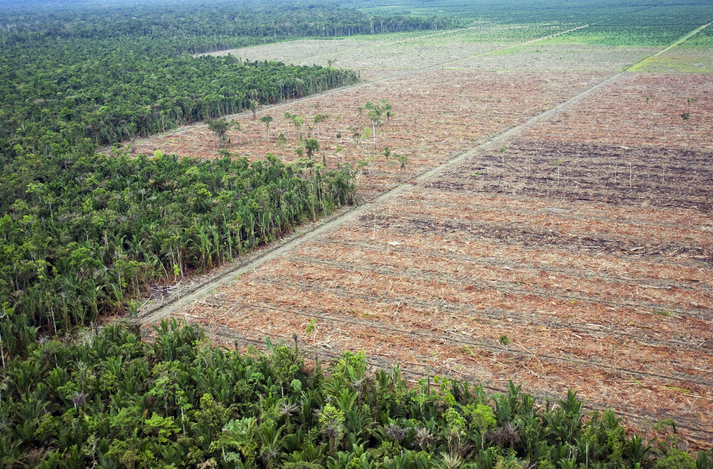Impatto ambientale degli allevamenti intensivi in America Latina
L’alimentazione basata su prodotti animali porta a rilevanti conseguenze, prime fra tutti il consumo di moltissime risorse e la produzione di elevati livelli di inquinamento.
Grandissime quantità d’acqua sono destinate agli allevamenti per abbeverare gli animali, per la pulizia degli allevamenti stessi, e soprattutto per l’agricoltura. In totale, si stima che ben il 70% dell’acqua utilizzata sull’intero pianeta venga utilizzata nella zootecnia e nell’agricoltura. L’Animal Water Footprint (il calcolo del consumo di acqua totale utilizza per produrre un prodotto) relativa ad un bovino da latte sia circa quattro litri di acqua consumata per ogni litro di latte prodotto. Per produrre un chilo di carne di manzo sono necessari circa 100.000 litri di acqua; ne bastano invece 500 per un chilo di patate, o 2000 per un chilo di soia e così via.
Ben il 70% della terra è utilizzato per la produzione zootecnica e agricola, specialmente per la coltivazione di foraggio. La ricerca di nuove terre da coltivare ha dato il via ad una desertificazione su larga scala, abbattendo la foresta sudamericana e bonificando territori per fare spazio alle coltivazioni. Ma se tutta l’umanità iniziasse a mangiare carne allo stesso ritmo occidentale, circa 80/100 kg pro capite all’anno, sarebbe necessaria una superficie pari a due o tre volte quella di tutta la terra stessa, da adibire al pascolo e soprattutto alle coltivazioni di foraggio.
La produzione di alimenti di origine animale provoca elevatissimi livelli di inquinamento, causati principalmente dalle deiezioni animali e dai pesticidi utilizzati per le colture; Per allevare un bovino viene prodotta mediamente 1636kg di CO2eq all’anno; la produzione di un kg di banane ne produce 0,5 kg. Secondo un rapporto FAO, gli allevamenti intensivi hanno dunque il triste primato di maggiori produttori di gas serra. Il 18% del gas serra prodotto a livello globale deriva dagli allevamenti di animali contro il 13,5% dell’intero settore dei trasporti, aviazione compresa.
Ad oggi, l’allevamento intensivo è considerato la principale causa della deforestazione, che porta ad un maggior impoverimento dei terreni: questi senza alberi trattengono in maniera meno efficace le acque, aumentando così le frane e le inondazioni, e limitando l’approvvigionamento delle falde acquifere sotterranee con una conseguente maggiore siccità.
Inoltre, il disboscamento e la desertificazione sottraggono l’habitat naturale a molte specie, e mettono in pericolo la possibilità di sostentamento di più di un miliardo di persone. Le zone aride ad oggi rappresentano il 41,3% delle terre emerse, e vi vive una persona su tre.
La maggior parte degli allevamenti intensivi e dei terreni agricoli per il foraggio si trova nei Paesi in via di Sviluppo, specialmente in America Latina: il boom economico degli anni passati ha utilizzato, e utilizza tutt’ora, il sud del mondo come un serbatoio di risorse, togliendo ai Paesi sottosviluppati la possibilità di crescere, sottraendo materie prime e sfruttando le loro terre per l’allevamento e l’agricoltura. Si stima che circa ogni anno 17 milioni di ettari di foreste tropicali vengano distrutte. Naturalmente la causa non è unicamente riconducibile agli allevamenti intensivi, ma grande parte della responsabilità è loro: circa il 70% delle zone disboscate in Costa Rica e a Panama sono ora diventate pascoli.
Location
Latin America, Amazon Rainforest
Environmental impact
- Water pollution
- Land degradation (e.g. drought, soil contamination, erosion and desertification)
- Biodiversity loss – Ecosystem destruction
- Depletion of natural resources (fossil and mineral, forest, water, etc)
- Hazards related to extreme weather events – natural disaster
Ethical/ legal issues
- Health and well-being
- A clean and prosperous environment and a safe and pleasant habitat
- Indigenous land, culture and rituals
Information sources & materials
Scientific/ academic journal papers
Pulina, G., Francesconi, A., Mele, M., Ronchi, B., Stefanon, S. e Sturaro, E. (2011). Sfamare un mondo di nove miliardi di persone:le sfide per una zootecnia sostenibile. Italian Journal of Agronomy.
Scientific/ academic books and chapters
Pimmentel, D. e Pimmentel, M. (2003). Sustainability of meat-based and plant-based diets and the environment. New York: Am J. Clin Nuy.
Shue, H. (2114.). Climate justice. Oxford: Oxford University Press.
Scientific/ academic reports
Anon (2017) Drivers of Deforestation and Forest Degradation Report [ Accessed 27 Apr. 2017].
Online books and newspaper, magazine, encyclopedia, or blog articles
Carus, F. (2010). UN urges global move to meat and dairy-free diet. The Guardian [ Accessed 27 Apr. 2017].
D’Amico, D. (2015). Dagli allevamenti intensivi arriva il 20 per cento dei gas serra. Repubblica.it. [Accessed 28 Apr. 2017].
Legal & public policy reports and documents
Fao.org. (2016). World Livestock 2011 – Livestock in food security. [Accessed 27Apr. 2017].
Links to images, online videos, documentary movies, etc
Deforestation of Brasil 1900 – 2000
What is derorestation? Video
The environmental impact of the animal product processing industries, FAO
Contributor(s)
Martina Conchione, martina.conchione@gmail.com, CeVI collaborator, Italy



Home › Forums › Environmental impact of the animal based products in Latin America